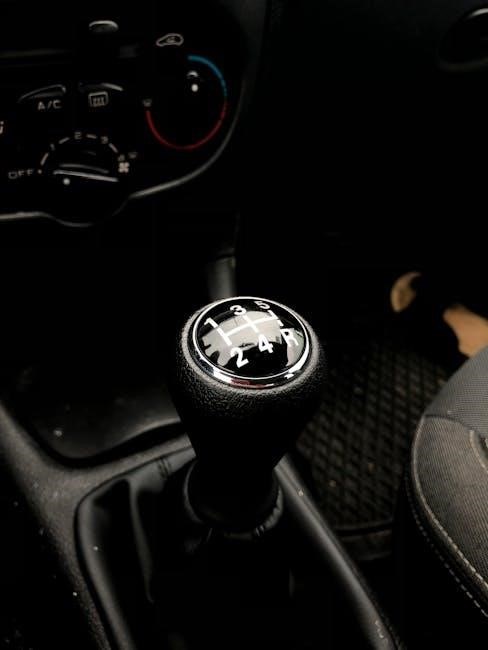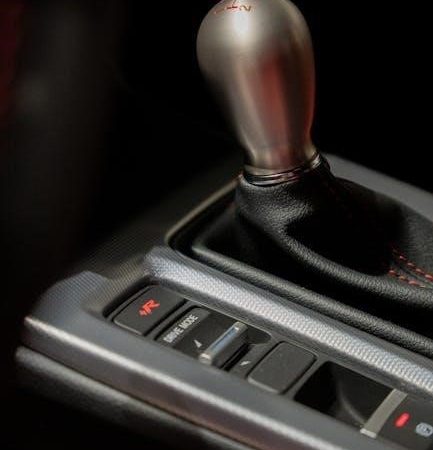Common Symptoms of a Bad Manual Transmission
A bad manual transmission often exhibits slipping gears, a burning smell, or grinding noises when shifting․ These issues can quickly escalate if left unaddressed, leading to costly repairs․
1․1 Slipping or Non-Engaging Gears
One of the most noticeable symptoms of a bad manual transmission is slipping or non-engaging gears․ This occurs when the gears fail to hold their position, causing the car to lose acceleration even with the pedal pressed․ Drivers may feel a lack of control during shifting, as if the gears are not responding․ This issue can be due to worn clutch components or low transmission fluid levels․ If left unaddressed, it may lead to further damage, such as grinding or complete gear failure․ It’s crucial to inspect the clutch and transmission fluid promptly to avoid costly repairs․ Early detection and maintenance can prevent the problem from escalating into a major mechanical failure․ Always consult a professional mechanic for accurate diagnosis and timely solutions to ensure smooth gear operation․ Regular checks can help maintain the transmission’s performance and longevity․
1․2 Burning Smell While Driving
A burning smell while driving is another concerning symptom of a bad manual transmission․ This odor often results from overheating components, such as the clutch or gears, due to excessive friction․ If the clutch is worn or not disengaging properly, it can overheat and produce a burning scent․ Similarly, degraded transmission fluid or excessive wear on gear synchronizers can also cause this smell․ Ignoring this symptom can lead to irreversible damage, as overheating can warp metal components or destroy the clutch․ It’s essential to stop driving and inspect the transmission immediately․ A professional mechanic should assess the issue to determine if the clutch, fluid, or other parts need replacement․ Addressing this symptom early can prevent further damage and costly repairs down the line․ Regular maintenance, such as checking transmission fluid levels and condition, can help prevent such issues from arising․ Timely action is crucial to ensure the longevity of the transmission and overall vehicle performance․
1․3 Grinding or Noises When Shifting
Grinding or unusual noises when shifting gears are clear indicators of a manual transmission issue․ These sounds often occur due to worn or damaged components, such as gear teeth, bearings, or synchronizers․ If the gears grind when shifting into specific gears, it may signal misalignment or wear in the gearset․ Similarly, a low transmission fluid level or contaminated fluid can cause improper lubrication, leading to noise․ In some cases, a damaged clutch or pilot bearing can also produce grinding sounds․ It’s important to address this symptom promptly, as continued operation can exacerbate the damage․ Noises during shifting should never be ignored, as they often precede more severe issues like gear failure or transmission lock-up․ Regular maintenance, such as checking and replacing the transmission fluid, can help prevent these problems․ If the noise persists, a professional inspection is necessary to identify and repair the underlying cause․ Early intervention can save significant repair costs and ensure smooth gear engagement․

Key Indicators of Manual Transmission Problems
Grinding or unusual noises during gear shifts are key indicators of manual transmission problems․ These sounds often result from worn or damaged components like gear teeth, bearings, or synchronizers․ If grinding occurs when shifting into specific gears, it may signal wear or misalignment in the gearset․ Low or contaminated transmission fluid can also cause improper lubrication, leading to noise․ Additionally, a damaged clutch or pilot bearing can produce grinding sounds․ Ignoring these noises can lead to further damage, such as gear failure or transmission lock-up․ Regular maintenance, like checking fluid levels, can help prevent these issues․ Persistent noise warrants professional inspection to identify and repair the underlying cause, ensuring smooth gear engagement and preventing costly repairs․ Early intervention is crucial to avoid severe transmission damage․
2․1 Leaking Transmission Fluid
Leaking transmission fluid is a critical indicator of manual transmission issues․ The fluid is essential for lubricating gears and maintaining optimal performance․ If leaks occur, it can lead to overheating, gear damage, and eventual failure․ Low fluid levels may cause gears to slip or engage improperly, resulting in poor acceleration and control․ Regular inspection of the transmission pan, seals, and lines is vital to detect leaks early․ Ignoring this issue can escalate into costly repairs, such as replacing damaged components or the entire transmission․ Addressing leaks promptly ensures smooth operation and extends the lifespan of the manual transmission․ Always check for signs of fluid loss and maintain proper levels to prevent complications․ Early intervention is key to avoiding severe damage and maintaining reliable vehicle performance․ Transmission fluid leaks are a clear warning that professional attention is needed immediately․ Regular maintenance can prevent such issues from arising․
2․2 Shuddering or Juddering During Acceleration
Shuddering or juddering during acceleration is a concerning symptom of manual transmission issues․ This vibration or shaking, often felt while speeding up, can indicate worn or damaged gears, bearings, or synchronizers․ Such irregularities disrupt smooth power transfer, leading to an unstable driving experience․ If left unchecked, the problem may worsen, causing further damage to internal components․ Low transmission fluid levels or contamination can also contribute to this issue, as proper lubrication is essential for smooth operation․ Drivers should address this symptom promptly to prevent accelerated wear on the transmission system․ Regular maintenance, such as fluid checks and component inspections, can help identify and resolve the root cause before it leads to costly repairs or complete transmission failure․ Ignoring this issue risks further complications and potential breakdowns while driving․
2․3 Difficulty Shifting Gears
Difficulty shifting gears is a clear indicator of a manual transmission problem․ This issue can manifest as stiff or unresponsive gear shifts, making it hard to engage or disengage gears smoothly․ Common causes include worn or damaged synchronizers, which help gears mesh properly, or issues with the shift linkage or clutch․ Low or contaminated transmission fluid can also impair gear engagement, leading to labored shifting․ In some cases, warped or damaged gear teeth may prevent gears from aligning correctly․ Ignoring this symptom can lead to further damage, such as stripped gears or complete transmission failure․ Early diagnosis is crucial to prevent costly repairs․ If shifting becomes consistently difficult, it’s important to have the transmission inspected by a professional to address the underlying cause and restore smooth operation․ Regular maintenance can help prevent such issues from arising․

Causes of Manual Transmission Issues
Manual transmission problems often arise from worn clutch components, low or contaminated fluid, synchronizer failure, or damaged shaft bearings, all leading to poor gear engagement and operational issues․
3․1 Worn Clutch Components
Worn clutch components are a primary cause of manual transmission issues․ Over time, the clutch disc, pressure plate, or release bearing can degrade, leading to slipping or dragging sensations․ This results in difficulty engaging gears smoothly, often accompanied by a spongy or unresponsive clutch pedal․ If the clutch fails to disengage properly, it can cause grinding noises when shifting or make it hard to transition between gears․ Ignoring these symptoms can lead to further damage, such as worn synchros or gear teeth․ Regular inspection and replacement of clutch components are essential to maintain smooth transmission operation and prevent costly repairs down the line․ Early detection of worn parts can help extend the lifespan of the manual transmission system․
3․2 Low or Contaminated Transmission Fluid

Low or contaminated transmission fluid is a common culprit behind manual transmission problems․ The fluid lubricates gears and bearings, and its degradation or depletion can lead to grinding noises, slipping gears, and increased friction․ Over time, dirt, metal shavings, or burnt fluid can contaminate the system, reducing its effectiveness․ Symptoms include difficulty shifting, a burning smell, or a shuddering sensation during acceleration․ Regular fluid checks and changes are crucial to prevent these issues․ If the fluid level drops too low, the transmission may overheat, causing irreversible damage․ Addressing fluid-related problems early can prevent costly repairs and ensure smooth gear engagement and operation․ Always use the recommended type of transmission fluid to maintain optimal performance and longevity of the manual transmission system․
3․3 Synchronizer Problems
Synchronizer problems are a frequent issue in manual transmissions, often causing grinding noises or difficulty shifting gears․ Synchronizers are responsible for ensuring smooth transitions between gears by equalizing their speeds․ When they wear out or become damaged, drivers may experience hesitation or a refusal to engage gears, particularly when downshifting․ This can lead to a grinding sensation or a clunking noise during gear changes․ If left unaddressed, synchronizer failure can escalate, requiring costly repairs․ Regular maintenance, such as inspecting and replacing worn synchronizers, is essential to prevent these issues․ Ignoring the problem can result in further damage to the transmission, potentially leading to a complete overhaul․ Addressing synchronizer problems early ensures smoother shifting and extends the lifespan of the manual transmission system․
3․4 Failing Shaft Bearings
Failing shaft bearings are a critical issue in manual transmissions, typically manifesting as loud grinding or whining noises during operation․ These bearings support the transmission’s gears and shafts, ensuring smooth rotation․ When they degrade, the noise becomes more pronounced, especially when accelerating or decelerating․ If ignored, failing bearings can cause gears to seize or complete transmission failure, leading to expensive repairs․ Vibration in the clutch pedal or gearshift may also occur as the bearings wear down․ Regular lubrication and inspection are vital to prevent bearing failure․ Addressing the issue promptly can prevent further damage and maintain the transmission’s performance․ Ignoring these symptoms risks catastrophic failure, necessitating a full transmission rebuild or replacement․ Early detection is key to minimizing repair costs and ensuring the longevity of the manual transmission system․

Consequences of Ignoring Transmission Symptoms
Neglecting signs of a failing manual transmission can lead to severe and costly repercussions․ Ignoring symptoms like slipping gears, grinding noises, or fluid leaks allows minor issues to escalate into major problems․ Over time, damaged components can cause the transmission to fail entirely, leaving the vehicle inoperable․ In such cases, a full rebuild or replacement becomes necessary, which is both time-consuming and expensive․ Additionally, a failed transmission can damage other critical systems, such as the engine and drivetrain, further increasing repair costs․ Regular maintenance and prompt repairs are essential to prevent these consequences and ensure the longevity of the vehicle․ Addressing issues early not only saves money but also avoids the inconvenience of unexpected breakdowns․ Transmission failure can strand drivers, making it a critical system to monitor and maintain diligently․
